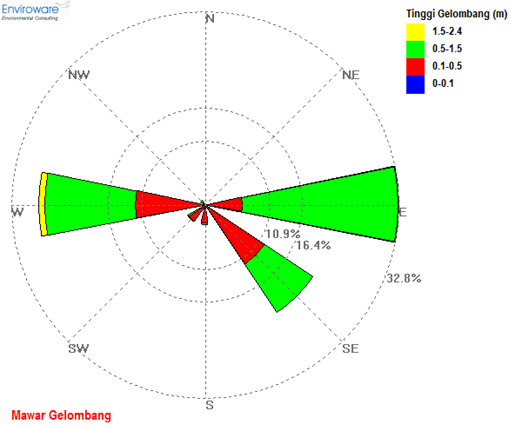Application of Composite Hanging Breakwater as a Pool Protector for Bantaeng Harbor
Main Article Content
Abstract
Bantaeng Port already has a dock for the loading and unloading goods and passengers. The problem is, the port cannot be operated optimally because of the large wave height at the dock so that the loading and unloading process is not optimal. The Bantaeng Port Master Plan document recommends the construction of a breakwater. One type of breakwater that can be applied is hanging breakwater. This study analyzes the dimensions of hanging breakwater based on environmental data. The study began by collecting data on deep-sea waves and related documents. Deep sea waves are analyzed to obtain wave parameters at the building site. This structure will be placed at a depth of 20 m. After the wave parameters at the location of the structure are known, then calculate the transmission coefficient using the equation developed by previous researchers [2]. The transmition coefficient is further used to calculate the wave behind the structure. The wave behind the structure must be smaller or equal to the required wave height [3]. The results obtained shows that the higher the wave in front of the building is Hi = 1.79 m, the wave height behind the structure is required is Ht = 0.7 m and the transmission coefficient is Kt = 0.8. The width of the building in the direction of wave propagation can be calculated using the equation L= 46.757e-0.08D.
Downloads
Article Details

This work is licensed under a Creative Commons Attribution 4.0 International License.
Allow anyone to modify, improve, and make derivative works, even for commercial purposes, as long as they credit to you for the original work.
References
Paotonan, C . (2015). Pendekatan analitis gelombang melalui pemecah gelombang tipe pilecap. Prosiding Seminar Nasional Teknik Sipil Universitas Muhammadiya.
C. Paotonan, H. Umar , S. Rahman, and T. Rachman. Analytical Approach of Wave Transmission Coefficient through on Composite Hanging Breakwater, Proceeding of The 6th International Conference on Marine Technology (SENTA 2021), Ocean Engineering Department Institut Teknologi Sepuluh November Surabaya
Anonim, 2019, Rencana Induk Pelabuhan Bantaeng.Dinas Perhubungan Provinsi Sulawesi Selatan
C. Paotonan, H. Umar, A.Y. Baeda, T. Rachman and W. Hasan, (2019). The Effect of Hanging Sheet Pile Breakwater’s Draft Relative on Wave Transmission Coefficient (Kt) in Irregular Wave, Proceeding of The 5th ISMMEE, Engineering Faculty University of Hasanuddin
S. Rahman and T. Pairunan, “Wave Force on Breakwater Structure in North Kalimantan”, mp, vol. 1, no. 1, pp. 26-33, Feb. 2022.
C. Paotonan, S. Rahman, H. Umar, T. Rachman, A.Y. Baeda, A. Mellolo and A. Hidayat, (2019). Experimental study on the influence of draft relative due to wave transmission energy coefficient on hanging sheet pile breakwater, Proceeding of The 5th ISMMEE, Engineering Faculty University of Hasanuddin.

